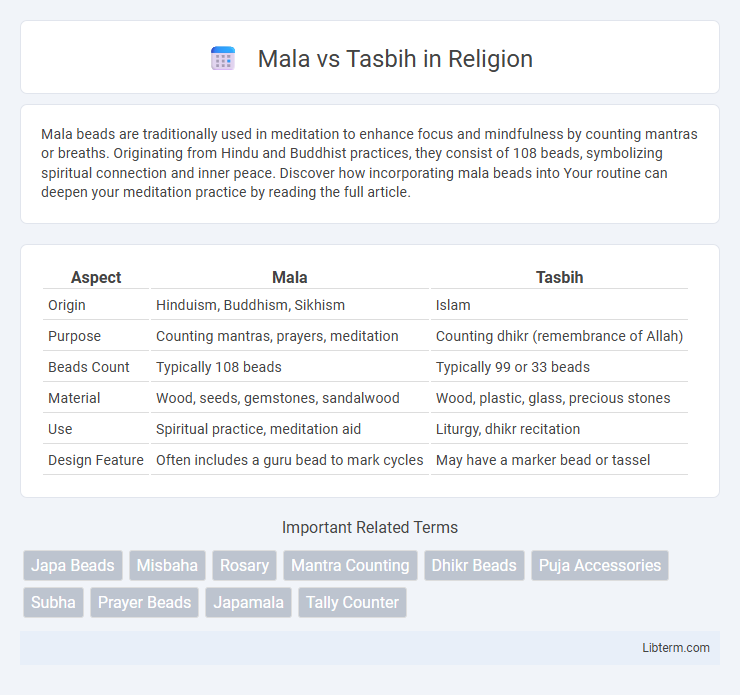Mala beads are traditionally used in meditation to enhance focus and mindfulness by counting mantras or breaths. Originating from Hindu and Buddhist practices, they consist of 108 beads, symbolizing spiritual connection and inner peace. Discover how incorporating mala beads into Your routine can deepen your meditation practice by reading the full article.
Table of Comparison
| Aspect | Mala | Tasbih |
|---|---|---|
| Origin | Hinduism, Buddhism, Sikhism | Islam |
| Purpose | Counting mantras, prayers, meditation | Counting dhikr (remembrance of Allah) |
| Beads Count | Typically 108 beads | Typically 99 or 33 beads |
| Material | Wood, seeds, gemstones, sandalwood | Wood, plastic, glass, precious stones |
| Use | Spiritual practice, meditation aid | Liturgy, dhikr recitation |
| Design Feature | Often includes a guru bead to mark cycles | May have a marker bead or tassel |
Introduction to Mala and Tasbih
Mala and Tasbih are both traditional prayer beads used in spiritual practices to aid in the repetition of mantras or prayers, with Mala commonly linked to Hinduism and Buddhism, typically consisting of 108 beads. Tasbih is primarily used in Islamic worship, featuring 33 or 99 beads to recite the names of Allah or phrases of dhikr. These tools facilitate meditation and devotion, enhancing focus and spiritual discipline across diverse religious traditions.
Historical Origins and Evolution
The mala and the tasbih both trace their historical origins to ancient spiritual practices, with the mala rooted in early Hindu and Buddhist traditions dating back over 2,500 years, used primarily for mantra repetition and meditation. The tasbih, emerging within Islamic culture around the 7th century CE, serves as a tool for dhikr, the remembrance of God, typically featuring 99 beads corresponding to the names of Allah. Over centuries, both prayer beads have evolved in design and material, reflecting cultural influences and religious symbolism unique to their respective faiths.
Materials and Design Differences
Malas are traditionally crafted from natural materials such as sandalwood, rudraksha seeds, and gemstones, emphasizing spiritual and tactile qualities, while tasbihs commonly use plastic, glass, or polished wood for durability and affordability. Design differences include the mala's 108 beads, often strung with a larger guru bead and decorative tassel, contrasted with the tasbih's 33 or 99 beads arranged in smaller segments for easier counting in Islamic prayer. Bead size and texture vary, with malas favoring textured, organic beads for a grounding feel and tasbihs opting for smoother, uniform beads to facilitate smooth finger movement.
Cultural and Religious Significance
Mala beads hold deep significance in Hinduism and Buddhism, used for mantra meditation and spiritual practices, often consisting of 108 beads symbolizing sacred numbers. Tasbih, integral to Islamic faith, serves as a tool for dhikr, helping Muslims recite the 99 Names of Allah or other prayers, typically made with 33 or 99 beads. Both items reflect a rich cultural heritage, aiding practitioners in mindfulness, devotion, and the repetition of prayers central to their religious beliefs.
Methods of Use in Spiritual Practices
Mala beads, typically consisting of 108 beads, are primarily used in Hindu and Buddhist meditation by counting mantras or breaths to deepen focus and enhance spiritual discipline. Tasbih, often featuring 99 beads corresponding to the 99 names of Allah, is used in Islamic prayer for reciting dhikr, fostering mindfulness and connection to the divine. Both tools serve as tactile aids to maintain rhythm and concentration in their respective spiritual practices.
Symbolism Behind Bead Count
Mala typically consists of 108 beads, symbolizing spiritual completion and the repetition of mantras in Hindu, Buddhist, and Jain practices. Tasbih usually contains 99 or 33 beads, representing the 99 names of Allah or divisions of prayer in Islamic tradition. The bead count in both Mala and Tasbih carries profound religious significance, guiding meditation, prayer rhythm, and focus during spiritual practices.
Regional Variations
Mala beads are traditionally used in Hinduism and Buddhism, primarily across South Asia, with 108 beads representing spiritual significance in meditation and chanting practices. Tasbih beads, commonly found in Islamic regions such as the Middle East and North Africa, typically have 99 or 33 beads to correspond with the names of Allah recited during devotional prayers. Regional variations influence bead materials and counts, reflecting local religious customs and cultural symbolism within each spiritual tradition.
Mala vs Tasbih: Functional Comparison
Mala beads and Tasbih beads serve similar functions in meditation and prayer, aiding in the repetition of mantras or divine names to enhance spiritual focus. Mala typically contains 108 beads, used primarily in Hindu and Buddhist practices for chanting or japa meditation, while Tasbih usually comprises 33 or 99 beads, specific to Islamic prayer for reciting phrases of glorification and remembrance of Allah. The functional difference lies in their religious context and bead count, influencing their use in respective devotional rituals.
Integration in Modern Spirituality
Mala and Tasbih beads serve as powerful tools for meditation and prayer, seamlessly integrating ancient spiritual practices into modern mindfulness routines. Both tools facilitate focused repetition of mantras or prayers, enhancing concentration and spiritual connection in daily life. Their adaptability to contemporary wellness practices reflects a growing trend of blending traditional spirituality with modern holistic health approaches.
Choosing the Right Prayer Beads for You
Choosing between mala beads and tasbih hinges on your spiritual practice and cultural background, as malas typically feature 108 beads used in Hindu and Buddhist meditation, while tasbih usually contains 99 or 33 beads for Islamic prayer. Consider the bead count, material quality such as sandalwood or amber, and the specific mantras or prayers associated with each to enhance your focus and connection during meditation or dhikr. Selecting the right prayer beads involves personal comfort and the resonance of the beads with your faith tradition and meditation goals.
Mala Infographic

 libterm.com
libterm.com